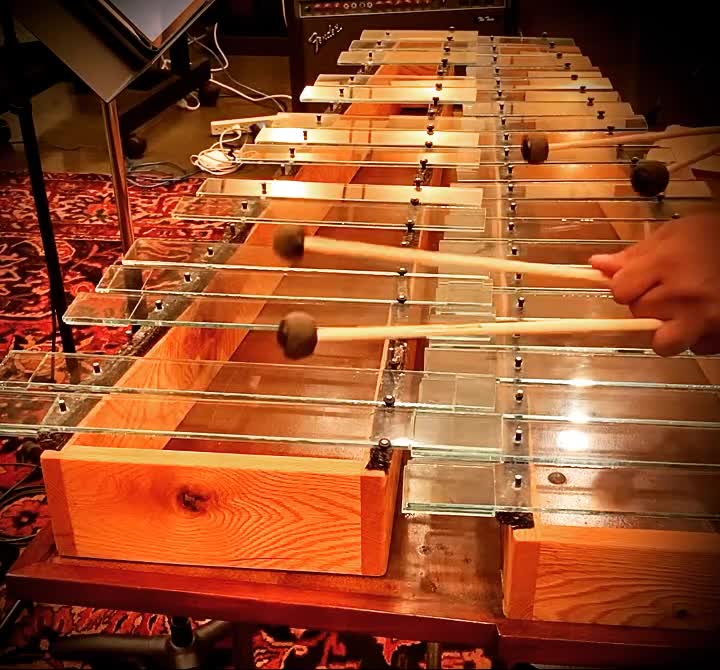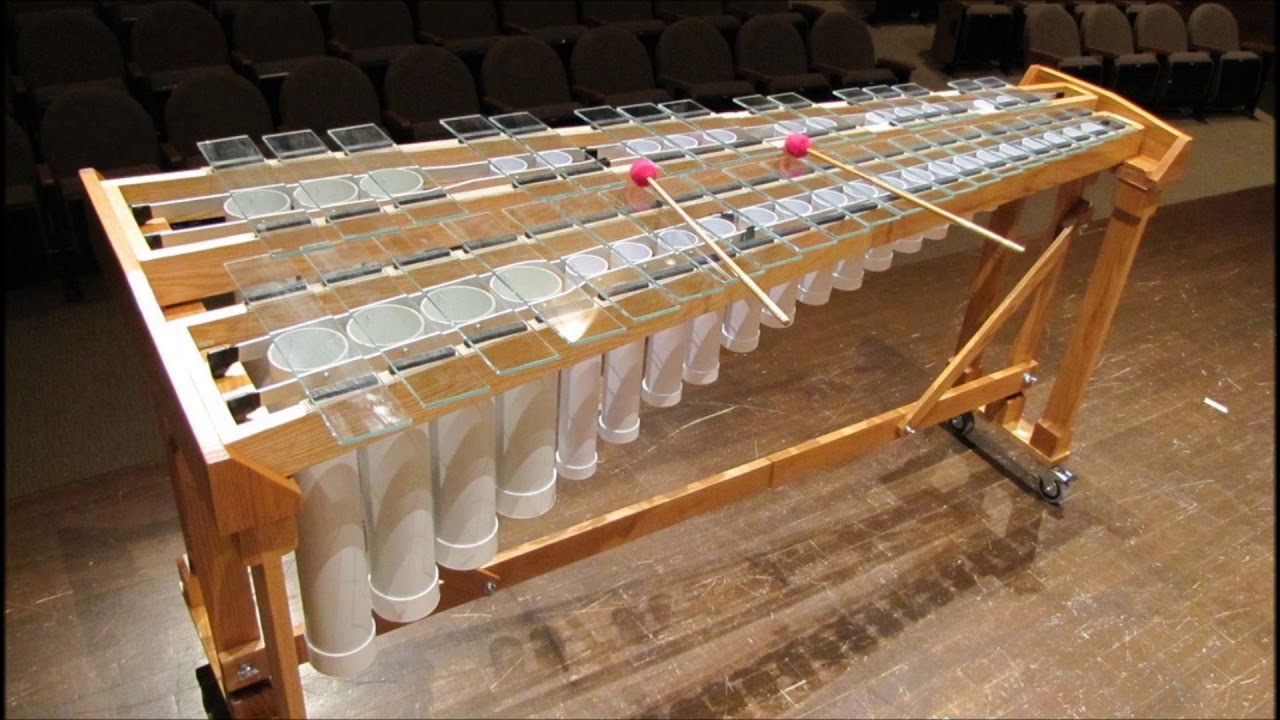Glass Marimba
Melodic Percussions
America
Between 1901 and present
Video
The glass marimba is a unique and innovative musical instrument that falls under the percussion family. It is a variation of the traditional marimba but is distinct due to its use of glass bars instead of wooden ones. The instrument produces ethereal and resonant tones that are different from the warm and earthy sounds of conventional marimbas. This distinction makes it a favored choice for experimental musicians and composers looking to create unconventional musical pieces.
The glass marimba is played using mallets, similar to its wooden counterpart. However, due to the material’s delicate nature, the mallets used are often softer, with rubber or felt heads to prevent breakage. The instrument can vary in size, with some models featuring a compact design suitable for solo performances and others being grander, used for orchestral or ensemble performances. Depending on the craftsmanship and design, glass marimbas can have various tonal ranges and tunings, allowing them to be adapted to different musical styles.
History and Origin
The concept of the glass marimba is relatively modern compared to other percussion instruments. While the marimba itself has origins dating back centuries, the glass adaptation is a product of contemporary innovation and artistic experimentation.
Continent and Century of Origin
Unlike traditional marimbas, which are deeply rooted in African and Latin American musical traditions, the glass marimba does not have a specific ethnic or cultural origin. Instead, it is a product of the fusion of musical innovation and material exploration. The first known use of glass in percussion instruments can be traced back to the early 20th century when instrument makers began experimenting with different materials to achieve unique sound qualities. By the late 20th and early 21st centuries, the glass marimba gained more recognition among avant-garde musicians and composers, who sought alternative sounds for their compositions.
Evolution and Development
The evolution of the glass marimba was influenced by various experimental music trends and the increasing accessibility of materials like tempered and borosilicate glass, which are more durable and suitable for musical applications. Early versions were handcrafted and often one-of-a-kind, but with technological advancements, more refined and professionally crafted glass marimbas became available. Today, these instruments are used in a variety of musical settings, from classical and contemporary compositions to electronic and ambient music.
Types and Features
The glass marimba comes in different types, each with distinct characteristics that define their sound, construction, and playing technique.
Types of Glass Marimbas
- Traditional Glass Marimba: These are designed to closely resemble wooden marimbas in terms of layout and playing style but use glass bars for a distinct tonal quality. The bars are often arranged chromatically, just like in a conventional marimba.
- Experimental Glass Marimba: These versions may feature unconventional layouts, tunings, and extended ranges. They are commonly used in experimental and electronic music, sometimes incorporating amplification or digital processing for enhanced sound effects.
- Portable Glass Marimba: A smaller and more compact version designed for easier transportation and personal performances. These models usually have fewer bars and a more limited range but maintain the signature glass resonance.
- Hybrid Glass Marimba: This type incorporates both glass and other materials, such as metal or wood, to create a hybrid sound. Some models may feature glass bars alongside metal resonators to amplify the sound, offering a mix of clarity and warmth.
Features of the Glass Marimba
The primary component, responsible for producing sound. These bars can be made of different types of glass, including borosilicate, tempered, or even fused glass for varying tonal qualities. Some glass marimbas incorporate resonators beneath the bars, much like traditional marimbas, to enhance sustain and volume. Designed specifically for striking the glass without causing damage. They often have soft rubber or felt heads. A sturdy frame is essential to support the glass bars. High-end models feature adjustable frames for ergonomic playing positions. Some modern glass marimbas integrate pickups or microphones for amplification in performances and recordings.
Work Mechanics
The mechanics of the glass marimba follow the same principles as other percussion instruments but with nuances due to the material properties of glass.
When a mallet strikes a glass bar, the impact creates vibrations that travel through the material. The frequency of these vibrations determines the pitch of the sound produced. Because glass is a denser and less porous material than wood, the resulting sound is more crystalline and sustained. The vibration patterns of glass differ significantly from those of wooden bars, leading to a more shimmering and bell-like tone.
The presence or absence of resonators further affects the sound. Traditional marimbas rely on tube-shaped resonators to amplify the sound, and while some glass marimbas incorporate these, others rely on the natural resonance of the glass itself. The spacing, thickness, and material composition of the bars also influence the tonal characteristics, making each glass marimba unique.
Role in Music
The glass marimba plays a distinctive role in various musical genres and settings. While it is not as widely recognized as its wooden counterpart, it has found a niche in contemporary and experimental music scenes.
Classical and Contemporary Music: Some composers have integrated the glass marimba into orchestral and chamber music settings to add a unique timbre to their compositions.
Experimental and Avant-Garde Music: Given its ethereal sound, the glass marimba is frequently used in experimental music, where musicians explore unconventional sonic textures.
Electronic and Ambient Music: The instrument’s natural sustain and shimmering overtones make it a popular choice in ambient and electronic music. When paired with digital effects, it creates rich, immersive soundscapes.
Film and Soundtrack Composition: The distinctive sound of the glass marimba makes it an excellent choice for film scores, particularly in fantasy or sci-fi settings where a magical or otherworldly atmosphere is required.
Solo and Ensemble Performances: While not as common as traditional marimbas, soloists and small ensembles use the glass marimba to showcase its delicate and mesmerizing tonal qualities.
Significance of the Glass Marimba
The glass marimba is significant not only for its unique sound but also for its role in expanding the possibilities of percussion music. Its introduction to the world of music challenges traditional perceptions of what a marimba can be, allowing for more diverse and expressive compositions.
Contribution to Musical Innovation
The glass marimba has contributed significantly to musical innovation by pushing the boundaries of percussion instruments. Composers and musicians are continually experimenting with new ways to incorporate its sound into different genres. The instrument’s ability to produce tones that are simultaneously percussive and melodic gives it a distinctive place in modern music.
Artistic and Aesthetic Appeal
Beyond its sonic attributes, the glass marimba is often appreciated for its visual appeal. The transparent or colored glass bars give it an artistic quality that enhances stage performances. It stands out as a statement piece in live music settings, adding a visual dimension to the auditory experience.
Expanding the Percussion Family
As a relatively new addition to the percussion family, the glass marimba represents the evolving nature of musical instruments. Its presence broadens the scope of percussive possibilities and encourages musicians to explore new textures and tones that were previously unattainable with traditional materials.
Influence on Future Instrument Design
The innovation behind the glass marimba paves the way for further experimentation with materials in musical instrument construction. It inspires luthiers, instrument makers, and sound designers to explore unconventional materials beyond wood and metal, potentially leading to more groundbreaking instruments in the future.
The glass marimba is an extraordinary musical instrument that brings together artistry, innovation, and unique tonal characteristics. While it may not yet be as widespread as traditional marimbas, its ethereal sound and experimental potential make it a valuable addition to modern music. Whether used in classical, ambient, electronic, or avant-garde compositions, the glass marimba continues to intrigue and inspire musicians around the world, proving that music is an ever-evolving art form with endless possibilities.
FAQ
What are the main characteristics of the Glass Marimba?
The Glass Marimba is characterized by its use of glass bars, which provide a warm and bright tone. It offers a broader tonal range compared to traditional marimbas and is known for its sustained sound production. The instrument is versatile and can be used in various musical genres. Its construction involves glass bars struck by mallets, often with resonators to enhance sound quality.
What is the origin of the marimba?
The marimba originated in Africa, where early versions were used in traditional music. It was brought to Central and South America during the slave trade, where it evolved significantly. In these regions, it became an integral part of local music, particularly in Guatemala and Mexico.
How does the Glass Marimba contribute to music?
The Glass Marimba contributes to music by offering a unique and distinctive sound. Its warm and bright tones make it appealing for composers seeking to add depth and variety to their works. It is versatile and can be used in various genres, from classical to contemporary music, enhancing the overall musical experience with its sustained and resonant sound.
 Links
Links
References
Other Instrument
Categories



















